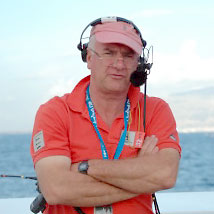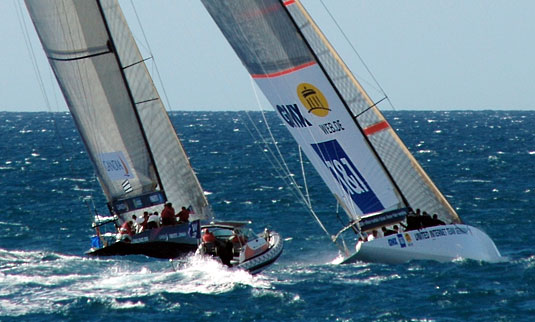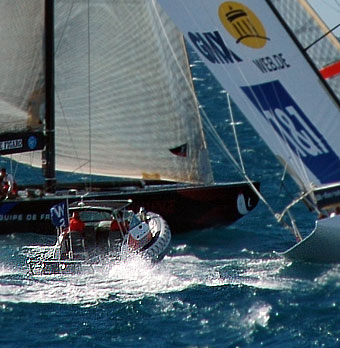|
As They See It: November 2005 |
||||||||||||||
As action raged in Trapani, CupInfo had the opportunity to chat with America's Cup Umpire John Standley, who shared his views on the differences between the Cup and other match racing events, match racing rules, the role of technology, and the relationship between umpires and the teams. CupInfo: John, what are the main differences between AC match racing rules and normal match racing rules such as in the Swedish Match Tour? John Standley: One of the main differences is that on the Swedish Match Tour, a boat going backwards by backing its sails doesn't have any right over one that isn't. That rule has been removed for the America's Cup because it is very difficult for the umpires to determine why a boat is going that way. These boats go backwards very easily, and a small backing of the jib to control the bow may cause the boat to go backwards. To make it clear to the sailors and the umpires we took that rule out. Another big change is that we have a three-boat-length zone at the leeward mark instead of a two-length zone. The boats are always judged to be about to round the mark when they enter the three-length zone. CI: What about the gate? JS: The gate is really new to match racing and I think it makes it quite exciting. I think that's one of the things that will end up going into normal match racing. It does bring in some logistical problem of getting the marks in the right place but we have very good race committees and good mark-laying teams. It may be that sometimes one mark gives a big advantage. But what it really does is that it creates passing lanes, as the boats can split and go up different sides on the beat. This puts much more pressure on the tactician. It gives the boat close behind an opportunity to make an immediate gain. CI: Is there any point where the two three-boat-lengths zones touch? JS: No, the marks should always be seven boat-lengths apart to prevent that sort of confusion. The rules apply certain restrictions and actually change when a boat leaves a three-boat-length zone to enter the other one. CI: How do you judge rule 17.1 in the America's Cup?
JS: That's the rule that states that when a boat comes from behind, that boat is restricted and cannot sail above its proper course. The communication system we're using now tells the boat when that rule applies. It's also used in the slam dunk situation on the beat. We get some very close tacks in front and a boat gets an overlap. Determining when this overlap occurs is very important because if there's not a 17 overlap, it becomes a leeward boat which now has luffing rights. Now we have this light system and we can tell them. We weren't operating that system in Malmo and we had a penalty when Alinghi thought they had a normal overlap and luffed and were penalized. CI: Unlike the last Cup, we haven't seen onboard umpires this year. JS: That's something the umpires like to do, because we feel we can give a better service. We get a much more accurate determination of when an overlap occurs when we're sitting in the back of boats. This is much more difficult when you're on a wing boat in a fairly rough sea as we had in Malmö, as the positioning of the boat is quite tricky and we may not be in the right place.... We would definitely prefer to be there on the boats, but there are two issues that some of the teams complain about: one of the problem is that we talk to the crew, but the crew that are non-English-speaking feel that they don't get the same information, or maybe as quickly as an English-speaking boat. And I also believe there have been some insurance problems. It may be that this changes, but we're also looking at technology to expand our current light system to feed the overlap information back to us automatically. If we can get the technology to do the work then we won't need the observers in the back of the boat. If we can't get it to work to the level of accuracy we need, then yes, we will still be asking if we can put the observers back on the boat. CI: Is it contemplated to run this light system on the Swedish Match tour? JS: I don't think it will get to that. I think it will be too expensive, and we have much smaller umpire boats and they're not suitable to put all this gear on, the yachts are also much smaller and do not have the necessary electronics. This is something that I think will remain just for the America's Cup, but who knows where we'll be in the future? This event is always at the forefront of technology. Some of the ideas that came in 1999 and 2000 are now common, rule changes have been made for the [Swedish Match] Tour and other Grade 1 events, and some of what we do here will get passed down to events like that as well, but some will always remain specific to the America's Cup. CI: Speaking of technology, are the umpires using Virtual Eye during racing or training? JS: We can't use it while racing because the accuracy of the position of the boats is not high enough for our purposes. But we are using it for our training, turning our lights on and off. It is very useful. We also use it together with the diagrams we draw on our TSS software to explain to the competitors what we saw. CI: Would any of this training material be available for the fans? JS: Yes. We do have an umpires website where one can find all the calls, rules changes, and documents, and the TSS files that we do after each incident will be onto the website shortly. We've had 191 incidents since first event in Marseille and they all are logged and illustrated with TSS diagrams. CI: Do team rule advisors go and visit you to have a look at these diagrams? JS: A team can ask for explanations on any incident. They also all receive a copy of the full diagrams after each round. We also have debriefing sessions with the competitors and rules advisors where calls are discussed.
CI: Can a team protest an umpire decision at the Jury? JS: No, they can't go to Jury, nothing can change an on-water decision, but they can query as this is part of education, and we are all human beings, we do make mistakes. CI: Do you switch umpires every day? JS: Yes, we do. It is important because if you're with the same person all the time it's quite possible that you could end up with your own slightly different interpretation on things, while what we desperately strive for is consistency in our decisions. For the same reason we also swap between the wing boat and umpire boat. CI: We don't see a lot of contact in these Acts. JS: The teams can't afford to have these boats hitting each other. These are big boats, there can be serious damage, and one can really get hurt in case of contact. However, there are a couple of teams who are more aggressive in their maneuvers. I will not name them but we are aware of some techniques. We know what their favorite moves are, we watch them and we prepare ourselves. CI: Thanks John! --from CupInfo ©2005
At Sailing.org:
At Challenger Commission Blog (offline as of
2009): |
|


